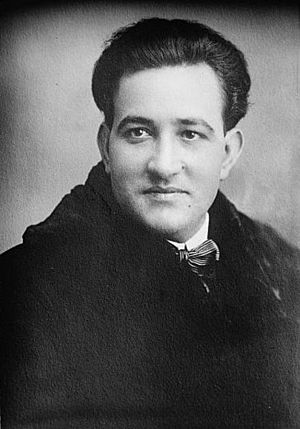Miguel Fleta facts for kids
Miguel Fleta was a famous Spanish opera singer. He was known for his amazing voice. Miguel was a lyric tenor, which means he sang high notes with a powerful, clear voice. He was born in 1897 in a town called Albalate de Cinca, Spain. He passed away in 1938 in A Coruña.
Quick facts for kids
Miguel Fleta
|
|
|---|---|
 |
|
| Born |
Miguel Burro Fleta
28 December 1897 Albalate de Cinca, Spain
|
| Died | 29 May 1938 (aged 40) A Coruña, Spain
|
| Occupation | Opera singer (Lyric tenor) |
| Years active | 1919–1935 |
Contents
Miguel Fleta's Early Career
Miguel Fleta started his opera career in 1919. Before that, he studied singing at the Madrid conservatory. His first big performance was in Trieste, Italy. After this, he had many successful shows in Rome.
Singing on Big Stages
His talent quickly led him to perform at some of the world's most famous opera houses:
- La Scala in Milan, Italy (from 1923 to 1926)
- The New York Metropolitan Opera (from 1923 to 1925)
He became very well-known in the opera world.
Creating a Famous Role
In 1926, Miguel Fleta had a very special honor. He was chosen to be the first singer to play the character of Calaf in Puccini's opera, Turandot. This opera was performed after Puccini had passed away. The main conductor at La Scala, Arturo Toscanini, insisted that Fleta sing this role.
The role of Calaf was very demanding for a singer. It required a lot of vocal power. After performing it, Fleta decided not to sing this role again.
Miguel Fleta's Unique Voice
During his best years, Miguel Fleta was praised for how skillfully he used his voice. He had a rich and flexible voice.
Bel Canto Technique
One of the most special things about his singing was his amazing bel canto technique. "Bel canto" means "beautiful singing" in Italian. It's a style that focuses on smooth, flowing melodies and showing off the singer's vocal skill.
This technique allowed him to create spectacular effects:
- Messa di voce: This is when a singer starts a note softly, makes it louder, and then brings it back to soft again, all in one breath.
- Pianissimo: This means singing very, very softly, but still with clear sound.
These skills made his performances truly memorable.
Later Career and Legacy
As Miguel Fleta's career continued, his singing style changed. By the late 1920s, recordings show that his voice was not as strong as it used to be. His vibrato (a slight, regular wavering of the voice) became too loose.
Miguel Fleta passed away in 1938. He left behind many recordings that are still interesting to listen to today. Many of these recordings are available on CDs.
See also
 In Spanish: Miguel Fleta para niños
In Spanish: Miguel Fleta para niños

